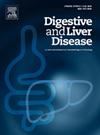Activation of AMPK by a novel complex I modulator (CIM) reduces lipid accumulation and mitigates fibrosis in an in vivo model of MASLD
IF 4
3区 医学
Q1 GASTROENTEROLOGY & HEPATOLOGY
引用次数: 0
Abstract
Introduction
Mitochondrial complex I dysfunction is linked to lipid accumulation and excessive ROS production, contributing to MASLD progression. Metformin, a known complex I inhibitor, promotes lipolysis and β-oxidation via AMP-activated protein kinase (AMPK), a key regulator of lipid metabolism. This study aims to assess whether a novel complex I modulator (CIM) regulates lipid metabolism and hepatic fibrosis with a similar mechanism.
Materials and Methods
male Wistar rats, fed with a Methionine and Choline deficient (MCD) diet or Control diet for 6 weeks, were orally administered with complex I modulator (CIM, 10mg/Kg/day) or vehicle for the last 3 weeks. ATP content, NAD(P)H bound/free ratio, lipid accumulation, collagen deposition, protein and mRNA expression of key lipid and fibrosis markers were analyzed.
Results
CIM administration significantly reduced intrahepatic lipid content in MCD-fed rats, compared with untreated ones. Histological analysis revealed a significant reduction in lipid droplets in both CIM-treated groups, compared with untreated ones. ATP and NAD(P)H bound/free ratio decreased in CIM-treated controls, versus vehicle-treated rats. Activated AMPK increased in both CIM-treated groups, but the effect was significant only in control diet rats. Nuclear PPAR-a levels significantly rose in CIM-treated MCD-fed rats, relative to the untreated ones, while its cytoplasmic levels were significantly reduced in the same samples. CIM administration significantly decreased mRNA expression of Srebp1c and its target genes Acaca and Fasn in CIM-treated controls, with a similar trend observed in SREBP1c and mTOR protein levels. CIM-treated rats also showed a significant reduction in collagen deposition in both control rats and rats fed with MCD diet, along with a significant decrease in a-SMA protein expression in CIM-treated MCD rats. The same trend, although not significant, was observed for fibronectin protein expression.
Conclusions
CIM appears to be a promising strategy to improve liver lipids metabolism and is beneficial to hepatic steatosis and fibrosis.
求助全文
约1分钟内获得全文
求助全文
来源期刊

Digestive and Liver Disease
医学-胃肠肝病学
CiteScore
6.10
自引率
2.20%
发文量
632
审稿时长
19 days
期刊介绍:
Digestive and Liver Disease is an international journal of Gastroenterology and Hepatology. It is the official journal of Italian Association for the Study of the Liver (AISF); Italian Association for the Study of the Pancreas (AISP); Italian Association for Digestive Endoscopy (SIED); Italian Association for Hospital Gastroenterologists and Digestive Endoscopists (AIGO); Italian Society of Gastroenterology (SIGE); Italian Society of Pediatric Gastroenterology and Hepatology (SIGENP) and Italian Group for the Study of Inflammatory Bowel Disease (IG-IBD).
Digestive and Liver Disease publishes papers on basic and clinical research in the field of gastroenterology and hepatology.
Contributions consist of:
Original Papers
Correspondence to the Editor
Editorials, Reviews and Special Articles
Progress Reports
Image of the Month
Congress Proceedings
Symposia and Mini-symposia.
 求助内容:
求助内容: 应助结果提醒方式:
应助结果提醒方式:


